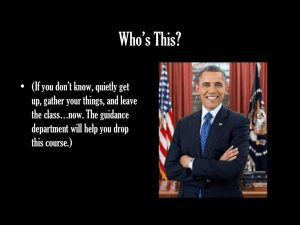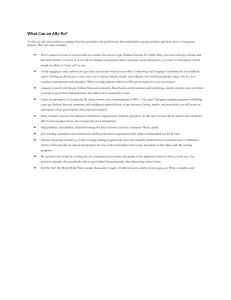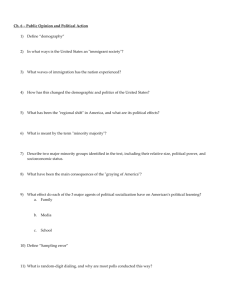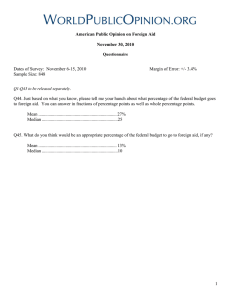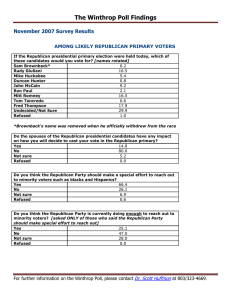The Gay, Lesbian, and Bisexual Vote in 2006
advertisement
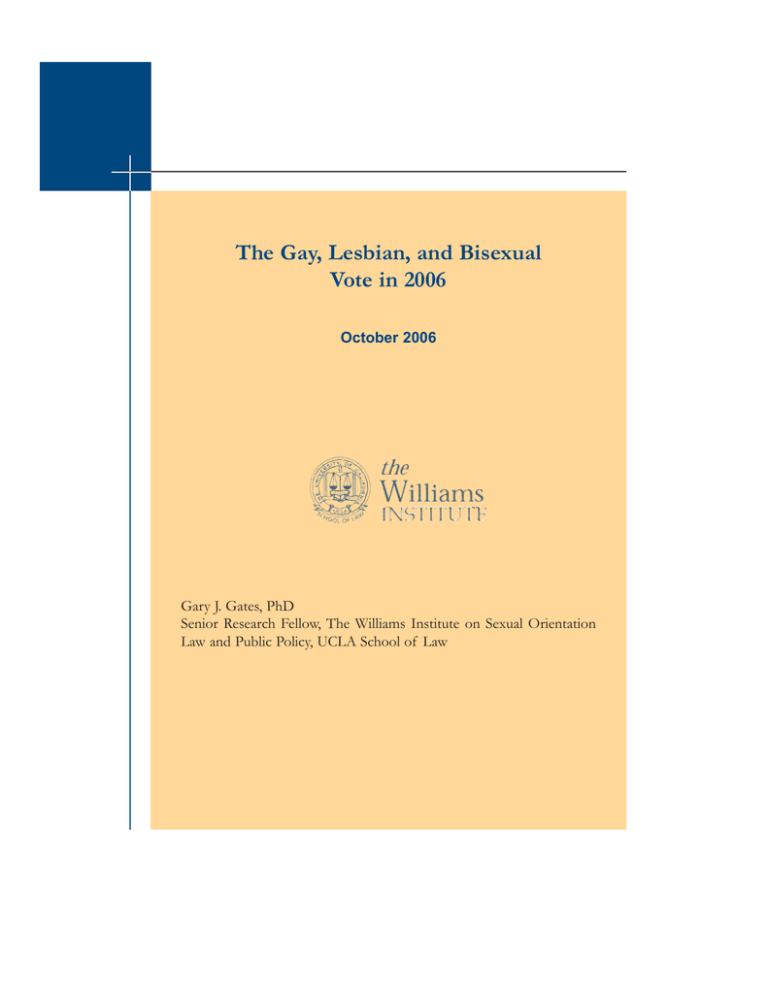
The Gay, Lesbian, and Bisexual Vote in 2006 October 2006 Gary J. Gates, PhD Senior Research Fellow, The Williams Institute on Sexual Orientation Law and Public Policy, UCLA School of Law The Gay, Lesbian, and Bisexual Vote in 2006 Gay, lesbian, and bisexual (GLB) voters may have a disproportionate impact in some key races in the upcoming election. An analysis of the GLB population in districts and states with competitive races shows the following: • In competitive House races with a Republican incumbent, an estimated 4.2 to 4.3 percent of adults are GLB, a figure above the national estimate of 4.1 percent and higher than proportions in tight races with an open seat or Democrat incumbent. • In Senate races with a Democrat incumbent, an estimated 4.5 percent of adults are GLB. • Among states with voter referenda that would ban marriage for same-sex couples, Arizona and Colorado have the highest proportions of GLB residents, 4.5 and 5.1 percent, respectively, and are the only two states with GLB population proportions above the national average. INTRODUCTION A recent Williams Institute analysis estimating the number of gay, lesbian, and bisexual adults living in each current congressional district provides an opportunity to consider the possible impact of the GLB vote in key races in upcoming Congressional elections.1 WA-8 Highlighted districts have 50K+ GLB residents October 2006 MA-8 CA-8 NY-8 CA-9 WILLIAMS INSTITUTE STUDY CA-45 1 GA-5 The Gay, Lesbian, and Bisexual Vote in 2006 While GLB voters are present in all Congressional districts, the map above demonstrates that some districts have a much higher proportion of GLB people (and likely GLB voters) than others. In particular, the following Congressional districts have more than 50,000 GLB residents who comprise more than ten percent of the adult population of that district: California-8th, California9th, California-45, Georgia-5th, Massachusetts-8th, New York-8th, and Washington-7th. IMPACT IN COMPETITIVE RACES Most political analyses suggest that 2006 is an unusually competitive election year, with control of both the House and Senate at stake. Among the more respected prognosticators, the Congressional Quarterly (CQ), Professor Larry Sabato of the University of Virginia's Center for Politics, and Chris Cillizza from the Washington Post each compile their own lists predicting which House seats are up for grabs. On the Senate side, nearly all pundits agree that eleven seats are competitive. WILLIAMS INSTITUTE STUDY October 2006 To assess the potential size of the GLB vote in competitive districts or states, this analysis took both the House races designated as "leaning" or "toss-ups" by Congressional Quarterly (53 races) and Larry Sabato (50 races), Chris Cillizza's Top 25 House races, and the eleven Senate races considered to be competitive, and categorized districts or states by those with an open seat and those with a Republican or Democrat incumbent.2 Then for each category, an estimate of the percentage of GLB adults in the population is shown (Table 1). 2 Table 1. Estimated percent of GLB individuals among adults within Congressional districts and states with competitive races, by party of incumbent. Estimated percent of GLB individuals among adults in competitive races House Senate Washington Combined Post CQ Sabato Incumbent Republican 4.2% 4.3% 4.2% 4.2% 3.8% Open 4.1% 4.0% 4.2% 4.0% 3.9% Incumbent Democrat 2.8% 3.0% 3.4% 2.7% 4.5% These estimates suggest that the GLB vote will likely have the largest impact in tight House races with a Republican incumbent and in Senate races where a Democrat is in a close contest. In the House races involving a Republican incumbent, an estimated 4.2 to 4.3 percent of adults are GLB. The Gay, Lesbian, and Bisexual Vote in 2006 In Senate races with a Democrat incumbent, an estimated 4.5 percent of adults are GLB. While both these figures are above the national 4.1 percent estimated GLB population,3 the estimated percentage of GLB residents in competitive districts with a Democratic House incumbent or in states with a Republican Senate incumbent are below the national average. In competitive House races with open seats, an estimated 4.0 to 4.2 percent of constituents are GLB compared to 3.9 percent in states where there is a competitive race for an open Senate seat. BALLOT INITIATIVES TO BAN MARRIAGE FOR SAME-SEX COUPLES Eight states-Arizona, Colorado, Idaho, South Carolina, South Dakota, Tennessee, Virginia, and Wisconsin-will be voting on a constitutional amendment that would ban marriage for same-sex couples. The impact of the GLB vote will likely be strongest in two states, Arizona and Colorado, with an estimated adult GLB population of 4.5 percent and 5.1 percent, respectively; both exceed the national average of 4.1 percent. The remaining states have estimated percentages ranging from 1.9 to 4.0 percent, all lower than the national average. An explanation of the methodology for estimating the size of the gay, lesbian, and bisexual population along with data for all competitive districts and states discussed in this report are included in the Appendix. WILLIAMS INSTITUTE STUDY October 2006 CONCLUSION 3 This analysis suggests that the impact of GLB voters will likely be greatest in competitive districts with a Republican House incumbent and in states with a Senate Democrat incumbent. In both cases, the estimated proportion of GLB residents exceeds the national average. This situation is also true in two states, Arizona and Colorado, with ballot initiatives that would ban marriage for same-sex couples. What kind of impact might these voters have? While empirical data on GLB voting behavior in individual districts or in most states is unavailable, it is notable that in both 2000 and 2004, more than three-quarters of GLB voters cast their ballots for the Democratic presidential candidate. Whether or not that pattern holds in 2006 remains to be seen, but this analysis offers evidence that GLB voters could play an important role in key races in the upcoming election. ACKNOWLEDGEMENTS Thanks to Jason Ost for providing the map. Thanks also to Ken Sherrill, Lee Badgett, and Brad Sears for helpful comments and Darcy Pottle and Deborah Ho for editorial assistance. The Gay, Lesbian, and Bisexual Vote in 2006 NOTES 1 See Gary J. Gates, "Same-sex Couples and the Gay, Lesbian, Bisexual Population: New Estimates from the American Community Survey," Williams Institute, October 2006 (http://www.law.ucla.edu/williamsinstitute/publications/SameSexCouplesandGLBpopACS.pdf) and Appendix for detail about estimating the size of the GLB population in states and Congressional districts. 2 Competitive districts were those listed as of Friday, 27 October 2006 by Congressional Quarterly (http://www.cqpolitics.com/risk_rating_house.html), Larry J. Sabato's Crystal Ball (http://www.centerforpolitics.org/crystalball/2006/house/) and the Washington Post's Chris Cillizza (http://blog.washingtonpost.com/thefix/). 3 Analyses from the National Survey of Family Growth find that 4.1 percent of men and women aged 18-45 identify as gay, lesbian or bisexual (National Survey of Family Growth, 2002). WILLIAMS INSTITUTE STUDY October 2006 APPENDIX 4 Methodology for estimating the size of the gay, lesbian and bisexual population Analyses from the National Survey of Family Growth estimate that 4.1 percent of men and women aged 18-45 identify as gay, lesbian or bisexual. If 4.1 percent of all adults in the United States identify as such, then an estimated 8.8 million adults are gay, lesbian, or bisexual. Data taken from the 2005 American Community Survey (ACS) provides estimates for the proportion of same-sex unmarried couples residing in all Congressional districts. By assuming that the proportion of same-sex couples who live in a state or Congressional district is the same as the proportion of all GLB individuals residing in that same area, ACS data can be used to estimate the total size of the GLB population within states and Congressional districts. The size of the GLB population in any area can be estimated by multiplying the estimate of 8.8 million GLB adults by the percentage of all same-sex couples residing in a given state or Congressional district. Appendix Table 1. Estimated size of the gay, lesbian, and bisexual population within Congressional districts with a competitive House race, 2006 District Name District 1, Arizona District 5, Arizona District 8, Arizona District 11, California District 50, California District 3, Colorado District 4, Colorado District 5, Colorado District 7, Colorado District 2, Connecticut District 4, Connecticut District 5, Connecticut District 13, Florida District 16, Florida District 22, Florida District 8, Georgia District 12, Georgia District 1, Idaho District 6, Illinois District 8, Illinois District 17, Illinois District 2, Indiana District 8, Indiana District 9, Indiana District 1, Iowa District 3, Iowa District 3, Kentucky District 4, Kentucky District 3, Louisiana District 1, Minnesota District 6, Minnesota District 2, Nevada District 3, Nevada District 2, New Hampshire District 7, New Jersey District 1, New Mexico District 19, New York District 20, New York Estimated % gay, lesbian, bisexual among adults 3.1% 3.8% 4.8% 5.1% 3.0% 2.4% 6.9% 3.9% 5.9% 5.6% 5.3% 2.8% 4.3% 3.6% 5.3% 3.5% 2.7% 2.0% 4.6% 3.2% 2.5% 3.5% 3.3% 3.5% 2.6% 2.6% 3.8% 3.8% 1.7% 2.4% 4.2% 3.6% 3.8% 7.0% 3.8% 5.4% 2.8% 4.7% Estimated number of gay, lesbian, bisexual residents Incumbent Party 15,470 19,747 25,540 26,864 15,374 11,544 33,772 18,413 27,224 28,471 26,635 14,659 24,870 20,568 28,313 19,301 12,030 10,579 22,169 16,829 11,614 16,740 16,037 17,701 11,396 11,507 19,266 19,830 8,263 10,966 21,516 20,178 24,978 33,406 18,764 26,079 13,703 23,621 Republican Republican Open Republican Republican Democrat Republican Open Open Republican Republican Republican Open Open Republican Democrat Democrat Open Open Democrat Open Republican Republican Republican Open Democrat Republican Republican Democrat Republican Open Open Republican Republican Republican Republican Republican Republican CQ Sabato X X X X X X X X X X X X X X X X X X X X X X X X X X X X X X X X X X X X X X X X X X X X X X X X X X X Washington Post X X X X X X X X X X X X X X X X X X X X X X X X X X X X X X X X X X X District 24, New York District 25, New York District 26, New York District 29, New York District 11, North Carolina District 1, Ohio District 2, Ohio District 15, Ohio District 18, Ohio District 4, Pennsylvania District 6, Pennsylvania District 7, Pennsylvania District 8, Pennsylvania District 10, Pennsylvania District 17, Texas District 22, Texas District 23, Texas District (at Large), Vermont District 2, Virginia District 8, Washington District 8, Wisconsin District (at Large), Wyoming 4.4% 4.7% 3.3% 4.2% 4.8% 2.7% 4.9% 5.8% 3.6% 2.7% 3.6% 5.2% 3.5% 3.1% 2.6% 4.3% 3.9% 5.1% 5.3% 6.3% 4.4% 3.0% 20,893 22,763 15,692 20,091 23,997 11,647 23,697 27,138 17,211 13,001 18,486 25,308 17,607 14,763 12,852 24,382 20,361 23,871 23,736 33,167 22,710 11,419 Open Republican Republican Republican Republican Republican Republican Republican Open Republican Republican Republican Republican Republican Democrat Open Republican Open Republican Republican Open Republican X X X X X X X X X X X X X X X X X X X X X X X X X X X X X X X X X X X X X X X X X X X X X X X X X X X X Appendix Table 2. State Maryland Missouri Montana Nebraska New Jersey Ohio Pennsylvania Rhode Island Tennessee Virginia Washington Estimated size of the gay, lesbian, and bisexual population within states with a competitive Senate race, 2006 Estimated % gay, lesbian, bisexual among adults 4.4% 3.8% 2.6% 3.4% 3.9% 4.0% 3.5% 3.4% 3.4% 4.0% 5.7% Estimated number of gay, lesbian, bisexual residents 178,266 160,912 18,703 42,934 245,628 335,110 323,454 27,040 148,868 220,309 266,983 Incumbent Party Open Republican Republican Democrat Democrat Republican Republican Republican Open Republican Democrat
